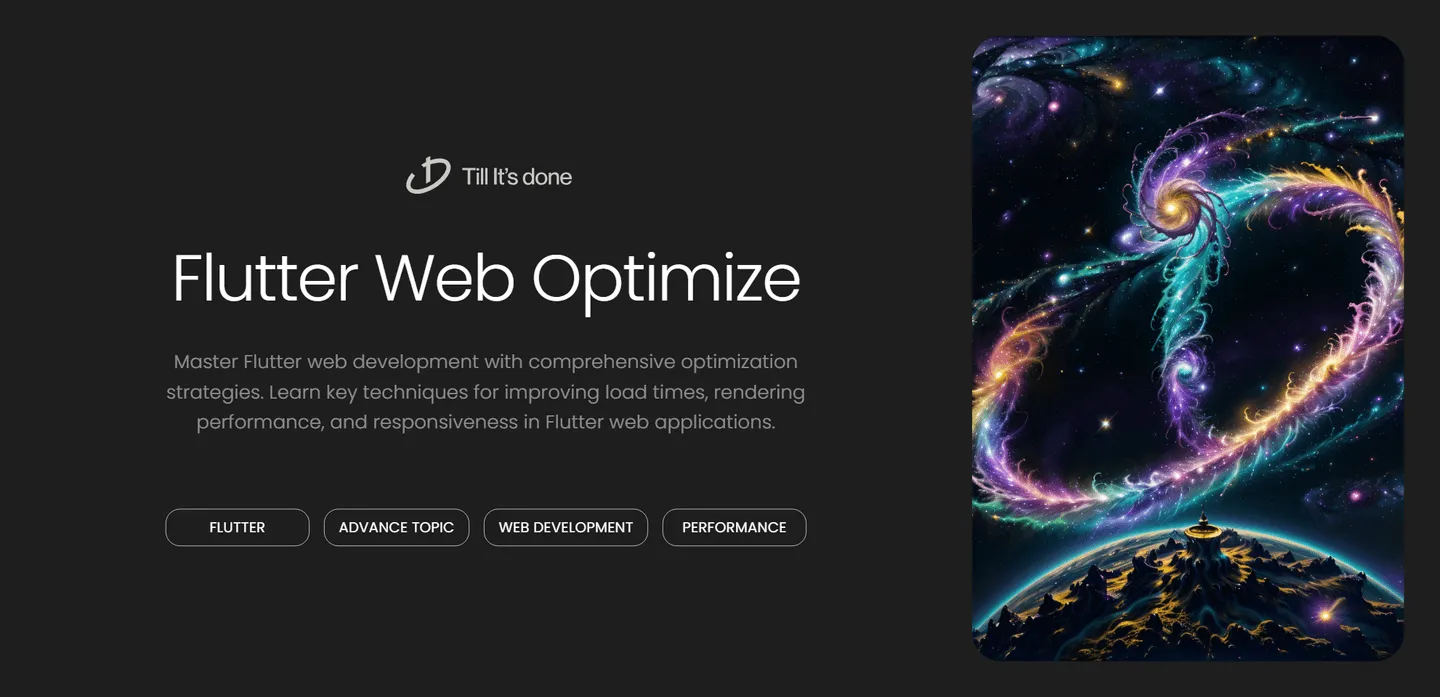- Services
- Case Studies
- Technologies
- NextJs development
- Flutter development
- NodeJs development
- ReactJs development
- About
- Contact
- Tools
- Blogs
- FAQ
Flutter Web: Optimize Performance & Response
Learn key techniques for improving load times, rendering performance, and responsiveness in Flutter web applications.


Flutter for Web: Optimizing Performance and Responsiveness
In today’s digital landscape, delivering exceptional web experiences is crucial. Flutter’s expansion into web development has opened new possibilities for creating responsive and performant web applications. Let’s dive into key strategies for optimizing Flutter web applications.
Understanding Flutter Web Architecture
Before diving into optimization techniques, it’s essential to understand how Flutter renders web content. Flutter web can render using two different renderers: HTML and CanvasKit. Each has its trade-offs, which directly impact your application’s performance.

Key Optimization Strategies
1. Choosing the Right Renderer
The HTML renderer offers faster initial load times and smaller download sizes but may sacrifice some rendering fidelity. CanvasKit provides pixel-perfect rendering but comes with a larger initial payload. Choose based on your application’s specific needs:
- Use HTML renderer for content-focused websites
- Prefer CanvasKit for applications requiring complex animations or precise visual consistency
2. Asset Optimization
Image Optimization
- Implement lazy loading for images
- Use appropriate image formats (WebP for better compression)
- Implement responsive image loading based on device capabilities
Font Optimization
- Subset fonts to include only necessary characters
- Consider using system fonts when possible
- Implement proper font loading strategies

3. Code Splitting and Lazy Loading
Implement effective code splitting strategies:
Future<void> loadModule() async { await DeferredComponent.load();}This approach helps reduce initial bundle size and improves startup time significantly.
4. State Management and Memory Optimization
Efficient state management is crucial for web performance:
- Use efficient state management solutions like Riverpod or Bloc
- Implement proper disposal of controllers and animations
- Monitor memory usage and implement cleanup strategies
5. Network Optimization
- Implement effective caching strategies
- Use compression for API responses
- Optimize API calls with batching and debouncing
6. Performance Monitoring
Implement performance monitoring using tools like:
- Flutter DevTools
- Custom performance overlays
- Web Vitals tracking
Real-world Implementation Tips
Remember these practical tips when optimizing your Flutter web application:
- Always test on multiple browsers and devices
- Measure performance metrics before and after optimization
- Consider progressive web app (PWA) implementation
- Use Flutter’s built-in performance widgets wisely
Future Considerations
Keep an eye on Flutter web’s evolving capabilities. The platform is continuously improving, with new features and optimizations being added regularly.

By implementing these optimization strategies, you can create Flutter web applications that not only look great but also perform exceptionally well across different devices and network conditions. Remember that optimization is an ongoing process - continuously monitor, measure, and improve your application’s performance based on real user metrics and feedback.
 สร้างเว็บไซต์ 1 เว็บ ต้องใช้งบเท่าไหร่? เจาะลึกทุกองค์ประกอบ website development cost อยากสร้างเว็บไซต์แต่ไม่มั่นใจในเรื่องของงบประมาณ อ่านสรุปเจาะลึกตั้งแต่ดีไซน์, ฟังก์ชัน และการดูแล พร้อมตัวอย่างงบจริงจาก Till it’s done ที่แผนชัด งบไม่บานปลายแน่นอน
สร้างเว็บไซต์ 1 เว็บ ต้องใช้งบเท่าไหร่? เจาะลึกทุกองค์ประกอบ website development cost อยากสร้างเว็บไซต์แต่ไม่มั่นใจในเรื่องของงบประมาณ อ่านสรุปเจาะลึกตั้งแต่ดีไซน์, ฟังก์ชัน และการดูแล พร้อมตัวอย่างงบจริงจาก Till it’s done ที่แผนชัด งบไม่บานปลายแน่นอน  Next.js สอน 14 ขั้นตอนเบื้องต้น: สร้างโปรเจกต์แรกใน 30 นาที เริ่มต้นกับ Next.js ใน 14 ขั้นตอนเพียงแค่ 30 นาที พร้อม SSR/SSG และ API Routes ด้วยตัวอย่างโค้ดง่าย ๆ อ่านต่อเพื่อสร้างโปรเจ็กต์แรกได้ทันทีที่นี่
Next.js สอน 14 ขั้นตอนเบื้องต้น: สร้างโปรเจกต์แรกใน 30 นาที เริ่มต้นกับ Next.js ใน 14 ขั้นตอนเพียงแค่ 30 นาที พร้อม SSR/SSG และ API Routes ด้วยตัวอย่างโค้ดง่าย ๆ อ่านต่อเพื่อสร้างโปรเจ็กต์แรกได้ทันทีที่นี่  วิธีสมัคร Apple Developer Account เพื่อนำแอปขึ้น App Store ทีละขั้นตอน อยากปล่อยแอปบน App Store ระดับโลก มาอ่านคู่มือสมัคร Apple Developer Account พร้อมเคล็ดลับ TestFlight และวิธีอัปโหลดที่ง่ายในบทความเดียวนี้ได้เลย
วิธีสมัคร Apple Developer Account เพื่อนำแอปขึ้น App Store ทีละขั้นตอน อยากปล่อยแอปบน App Store ระดับโลก มาอ่านคู่มือสมัคร Apple Developer Account พร้อมเคล็ดลับ TestFlight และวิธีอัปโหลดที่ง่ายในบทความเดียวนี้ได้เลย  TypeScript Interface คืออะไร? อธิบายพร้อมวิธีใช้และข้อแตกต่างจาก Type เรียนรู้วิธีใช้ TypeScript Interface เพื่อสร้างโครงสร้างข้อมูลที่ปลอดภัยและเข้าใจง่าย พร้อมเปรียบเทียบข้อดีข้อแตกต่างกับ Type ที่คุณต้องรู้ ถูกรวมเอาไว้ในบทความนี้แล้ว
TypeScript Interface คืออะไร? อธิบายพร้อมวิธีใช้และข้อแตกต่างจาก Type เรียนรู้วิธีใช้ TypeScript Interface เพื่อสร้างโครงสร้างข้อมูลที่ปลอดภัยและเข้าใจง่าย พร้อมเปรียบเทียบข้อดีข้อแตกต่างกับ Type ที่คุณต้องรู้ ถูกรวมเอาไว้ในบทความนี้แล้ว  Material-UI (MUI) คืออะไร อยากสร้าง UI สวยงามและเป็นมืออาชีพในเวลาอันรวดเร็วใช่ไหม มาทำความรู้จักกับ Material-UI (MUI) ที่ช่วยให้คุณพัฒนาแอปพลิเคชันบน React ได้ง่ายและดูดีในทุกอุปกรณ์
Material-UI (MUI) คืออะไร อยากสร้าง UI สวยงามและเป็นมืออาชีพในเวลาอันรวดเร็วใช่ไหม มาทำความรู้จักกับ Material-UI (MUI) ที่ช่วยให้คุณพัฒนาแอปพลิเคชันบน React ได้ง่ายและดูดีในทุกอุปกรณ์  เปรียบเทียบ 3 วิธีติดตั้ง install node js บน Ubuntu: NVM vs NodeSource vs Official Repo แบบไหนดีที่สุด? เรียนรู้วิธีติดตั้ง Node.js บน Ubuntu ด้วย NVM, NodeSource หรือ Official Repo เลือกวิธีที่เหมาะกับความต้องการของคุณ พร้อมเปรียบเทียบ เพื่อการพัฒนาที่มีประสิทธิภาพ!
เปรียบเทียบ 3 วิธีติดตั้ง install node js บน Ubuntu: NVM vs NodeSource vs Official Repo แบบไหนดีที่สุด? เรียนรู้วิธีติดตั้ง Node.js บน Ubuntu ด้วย NVM, NodeSource หรือ Official Repo เลือกวิธีที่เหมาะกับความต้องการของคุณ พร้อมเปรียบเทียบ เพื่อการพัฒนาที่มีประสิทธิภาพ! Talk with CEO
We'll be right here with you every step of the way.
We'll be here, prepared to commence this promising collaboration.
Whether you're curious about features, warranties, or shopping policies, we provide comprehensive answers to assist you.


